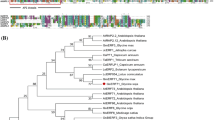Abstract
Key message
AtERF71/HRE2 binds to GCC box or DRE/CRT as transcription activator and plays an important role in root development via root cell expansion regulation.
Abstract
AtERF71/HRE2 transcription factor, a member of the AP2/ERF family, plays a key role in the stress response. GCC box and DRE/CRT, both essential cis-acting elements, have been shown to be recognized by AP2/ERF family transcription factors. However, it remains unclear whether or not AtERF71/HRE2 directly interacts with GCC box and/or DRE/CRT. Here, we showed that AtERF71/HRE2 binds to GCC box and DRE/CRT by electrophoretic mobility shift assay (EMSA). Binding of AtERF71/HRE2 to GCC box and DRE/CRT was also detected by fluorescence measurement and surface plasmon resonance spectroscopy (BIAcore) experiments. Folding properties of AtERF71/HRE2 proteins were characterized by CD spectroscopy, and AtERF71/HRE2 showed thermal stability as evidenced by two endothermic peaks (T d) at 53 and 65 °C. In addition, AtERF71/HRE2 showed transcriptional activation activity via GCC box and DRE/CRT in Arabidopsis protoplasts. Interestingly, AtERF71/HRE2 OXs showed increased primary root length due to elevated root cell expansion. Our data indicate that AtERF71/HRE2 binds to both GCC box and DRE/CRT, transactivates expression of genes downstream via GCC box or DRE/CRT, and plays an important role in root development through regulation of root cell expansion.





Similar content being viewed by others
Abbreviations
- DRE/CRT:
-
Dehydration-responsive element/C-repeat
- ERF:
-
Ethylene responsive factor
- HRE:
-
Hypoxia responsive ERF
References
Allen MD, Yamasaki K, Ohme-Takagi M, Tateno M, Suzuki M (1998) A novel mode of DNA recognition by a β-sheet revealed by the solution structure of the GCC-box binding domain in complex with DNA. EMBO J 17:5484–5496
Beemster GT, Baskin TI (1998) Analysis of cell division and elongation underlying the developmental acceleration of root growth in Arabidopsis thaliana. Plant Physiol 116:1515–1526
Hao DY, Ohme-Takagi M, Sarai A (1998) Unique mode of GCC box recognition by the DNA-binding domain of ethylene-responsive element-binding factor (ERF domain) in plant. J Biol Chem 273:26857–26861
Hess N, Klode M, Andres M, Sauter M (2011) The hypoxia responsive transcription factor genes ERF71/HRE2 and ERF73/HRE1 of Arabidopsis are differentially regulated by ethylene. Physiol Plant 143:41–49
Lee JH, Kim DM, Lee JH, Kim J, Bang JW, Kim WT, Pai HS (2005) Functional characterization of NtCEF1, an AP2/EREBP-type transcriptional activator highly expressed in tobacco callus. Planta 222:211–224
Licausi F, van Dongen JT, Giuntoli B, Novi G, Santaniello A, Geigenberger P, Perata P (2010) HRE1 and HRE2, two hypoxia-inducible ethylene response factors, affect anaerobic responses in Arabidopsis thaliana. Plant J 62:302–315
Okamuro JK, Caster B, Villarroel R, Montagu MV, Jofuku KD (1997) The AP2 domain of APETALA2 defines a large new family of DNA binding proteins in Arabidopsis. Proc Natl Acad Sci USA 94:7076–7081
Park JM, Park CJ, Park SB, Ham BK, Shin R, Paek KH (2001) Overexpression of the tobacco Tsi1 gene encoding an EREBP/AP2-type transcription factor enhances resistance against pathogen attack and osmotic stress in tobacco. Plant Cell 13:1035–1046
Park HY, Lee SY, Seok HY, Kim SH, Sung ZR, Moon YH (2011a) EMF1 interacts with EIP1, EIP6 or EIP9 involved in the regulation of flowering time in Arabidopsis. Plant Cell Physiol 52:1376–1388
Park HY, Seok HY, Woo DH, Lee SY, Tarte VN, Lee EH, Lee CH, Moon YH (2011b) AtERF71/HRE2 transcription factor mediates osmotic stress response as well as hypoxia response in Arabidopsis. Biochem Biophys Res Commun 414:135–141
Sakuma Y, Liu Q, Dubouzet JG, Abe H, Shinozaki K, Yamaguchi-Shinozaki K (2002) DNA-binding specificity of the ERF/AP2 domain of Arabidopsis DREBs, transcription factors involved in dehydration- and cold-inducible gene expression. Biochem Biophys Res Commun 290:998–1009
Seok HY, Tarte VN, Lee SY, Park HY, Moon YH (2014) Arabidopsis HRE1α, a splicing variant of AtERF73/HRE1, functions as a nuclear transcription activator in hypoxia response and root development. Plant Cell Rep 33:1255–1262
Sheen J (2001) Signal transduction in maize and Arabidopsis mesophyll protoplasts. Plant Physiol 127:1466–1475
Tang M, Sun J, Liu Y, Chen F, Shen S (2007) Isolation and functional characterization of the JcERF gene, a putative AP2/EREBP domain-containing transcription factor, in the woody oil plant Jatropha curcas. Plant Mol Biol 63:419–428
Thomashow MF (1999) Plant cold acclimation: freezing tolerance genes and regulatory mechanisms. Annu Rev Plant Physiol Plant Mol Biol 50:571–599
Xu ZS, Xia LQ, Chen M, Cheng XG, Zhang RY, Li LC, Zhao YX, Lu Y, Ni ZY, Liu L, Qiu ZG, Ma YZ (2007) Isolation and molecular characterization of the Triticum aestivum L. ethylene-responsive factor 1 (TaERF1) that increases multiple stress tolerance. Plant Mol Biol 65:719–732
Yamaguchi-Shinozaki K, Shinozaki K (1994) A novel cis-acting element in an Arabidopsis gene is involved in responsiveness to drought, low-temperature, or high-salt stress. Plant Cell 6:251–264
Zhang H, Huang Z, Xie B, Chen Q, Tian X, Zhang X, Zhang H, Lu X, Huang D, Huang R (2004) The ethylene-, jasmonate-, abscisic acid-, and NaCl-responsive tomato transcription factor JERF1 modulates expression of GCC box-containing genes and salt tolerance in tobacco. Planta 220:262–270
Acknowledgments
This research was supported by Basic Science Research Program through the National Research Foundation of Korea (NRF) funded by the Ministry of Education (2012R1A1B3001815 and 2014R1A1A2009023) and by the Research Fund Program of Research Institute for Basic Sciences, Pusan National University, Korea, 2013, Project No. RIBS-PNU-2013-306.
Conflict of interest
The authors have no conflict of interest.
Author information
Authors and Affiliations
Corresponding authors
Additional information
Communicated by Youn-Il Park.
S.-Y. Lee and E.Y. Hwang equally contributed to this paper.
Electronic supplementary material
Below is the link to the electronic supplementary material.
Rights and permissions
About this article
Cite this article
Lee, SY., Hwang, E.Y., Seok, HY. et al. Arabidopsis AtERF71/HRE2 functions as transcriptional activator via cis-acting GCC box or DRE/CRT element and is involved in root development through regulation of root cell expansion. Plant Cell Rep 34, 223–231 (2015). https://doi.org/10.1007/s00299-014-1701-9
Received:
Revised:
Accepted:
Published:
Issue Date:
DOI: https://doi.org/10.1007/s00299-014-1701-9




